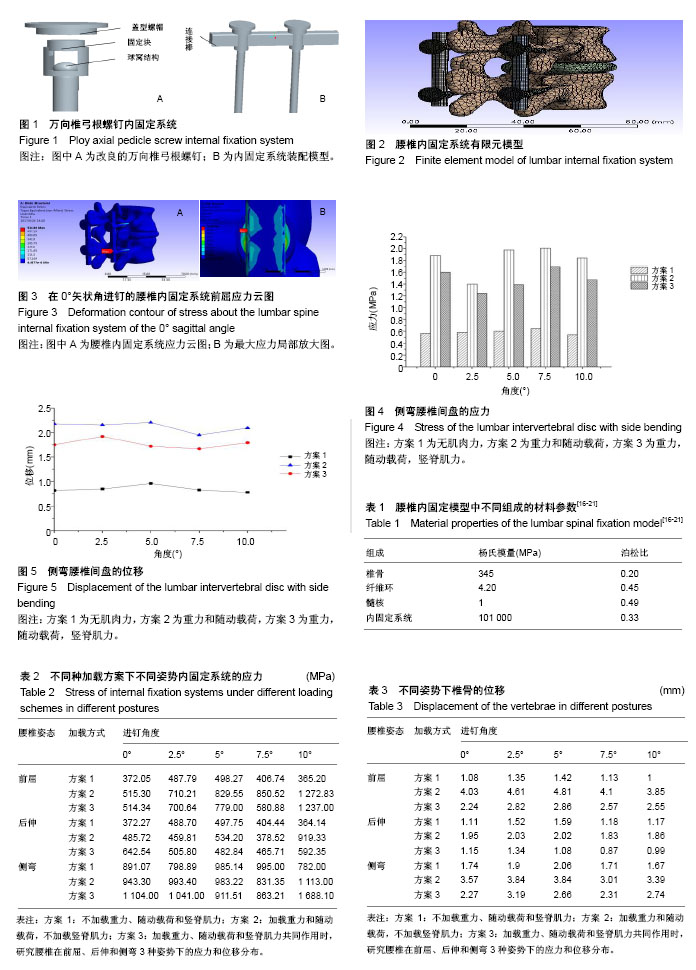| [1] 徐海涛,王文己.胸腰椎骨折的手术治疗进展[J].医学综述,2013,19(7): 1240-1243.[2] 张晓林,陈长宝,马信龙.胸腰椎骨折的分类系统及后路外科治疗的研究进展[J].天津医药,2013,41(07):733-736. [3] 彭俊,徐建广.胸腰椎骨折手术研究进展[J].中国修复重建外科杂志,2009, 23(12):1506-1509.[4] 胡海刚,王清,谭伦.伤椎椎弓根置钉植骨治疗胸腰椎骨折的应用现状及进展[J].中国组织工程研究,2012,16(48):9074-9078.[5] 傅栋,勒安民,宋磊,等人工髓核置换三维有限元模型的建立[J].中国组织工程研究与临床康复,2008,12(48):9401-9405.[6] Kazim SF, Enam SA, Hashmi I, et al.Polyaxial screws for lumbo-iliac fixation after sacral tumor resection: experience with a new technique for an old surgical problem.Int J Surg. 2009;7(6):529-533.[7] Kuklo TR, Potter BK, Polly DW, et al. Monaxial versus multiaxial thoracic pedicle screws in the correction of adolescent idiopathic scoliosis.Spine.2005;30(18):2113-2120.[8] 宋富立,靳安民,张美超,等.AF 内固定器不同置钉角度的有限元分析[J].临床生物力学,2005,2(33):310-312.[9] van Dieën J H, Cholewicki J, Radebold A.Trunk muscle recruitment patterns in patientswith low back pain enhance the stability of the lumbar spine.Spine.2003;28(8):834-839.[10] 滕红林,徐华梓,吴春雷,等.严重下腰椎爆裂性骨折不同程度手术方式的比较[J].中华创伤杂志,2009,25(2):135-137.[11] 马景新,王祥艳,许国星.短节段非融合椎弓根螺钉内固定修复胸腰椎爆裂骨折:中期随访[J] .中国组织工程研究, 2014,18(44):7088-7093 .[12] 贺新宁,欧晔灵,杜志勇,等.经皮椎弓根钉内固定治疗胸腰椎骨折[J].实用骨科杂志,2014,20(06):484-487.[13] Lindsey C, Deviren V, Xu Z, et al. The effects of rod contouring on spinal construct fatigue strength. Spine.2006;31(15):1680-1702.[14] 潘显明,谭映军,张波,等.椎弓根螺钉的螺纹形状与拔钉生物力学[J].第四军医大学学报,2002,23(5):447-450.[15] 汪宇,潘滔,李佛保,等.椎板钩对椎弓根螺钉系统应力影响的有限元分析[J].中国临床解剖学杂志,2006,24(2):209-211.[16] 余伟波,梁德,叶林强,等.3种不同后路内固定方式及其横连治疗胸腰段骨折的力学性能比较[J].医用生物力学,2016,31(2):142-147.[17] John K Houten, Rani N. Symptomatic progression of degenerative scoliosis after decompression and limited fusion surgery for lumbar spinal stenosis. Journal of Clinical Neuroscience.2013;20(4):613-615.[18] Verma K, Boniello A, Rihn J.Emerging Techniques for Posterior Fixation of the Lumbar Spine. J Am Acad Orthop Surg. 2016;24(6): 357-360.[19] Hrabálek L, Wanek T, Adamus M.Treatment of degenerative spondylolisthesis of the lumbosacral spine by decompression and dynamic transpedicular stabilisation.Acta Chirurgiae Orthopaedicae Et Traumatologiae Cechoslovaca. 2011;78(5):431-436.[20] 冯西桥,曹艳平,赵红平,等.生物材料力学研究新进展[J].医用生物力学, 2011,26(5):395-401.[21] 毕大卫,王伟,费骏,等.人体胸腰椎体冲击损伤的生物力学研究[J].中国骨伤,2010,2(10):772-775.[22] Kasten MD, Rao LA, Priest B. Long-term results of iliac wing fixation below extensive fusions in ambulatory adult patients with spinal disorders. Spinal Disord Tech.2010;23(7):37-42.[23] 余涛,任家来,黄德宁,等.椎弓根钉佐椎体成形术在胸腰椎骨折中的应用[J].安徽医,2008,29(1):40-41.[24] Bogduk N, Macintosh JE, Pearcy MJ. A universal model of thelumbar back muscles in the upright position. Spine.1992;17(8): 897- 913.[25] Wilke HJ, Rohlmann A, Neller S, et al. ISSLS Prize Winner: a novel approach to determine trunk muscle forces during flexion and extension: a comparison of data from an in vitro experiment and in vivo me asurements. Spine. 2003;28:2585-2593.[26] Rohlmann A, Neller S, Claes L, et al. Influence of a follower load on intradiscal pressure and intersegmental rotation of the lumbar spine. Spine.2001;26:E557-E561.[27] Foley KT, Gupta SK. Pereutaneous pedicle serew-rod fixation of the lumbar spine.Clin Neurol Neurosurg. 2001; 49(2):536-537.[28] Shepard MF, Davies MR, Abayan A, et al. Effects of polyaxial pedicle screws on lumbar construct rigidity.Spinal Disord Tech.2002;15(3):233.[29] Zender T, Rohlmann, Calisse J, et al. Estimation of muscle forces in the lumbar spine during upper bodyinclination. Clin Biomech. 2001; 16:S73-80.[30] 史可强,雷云霞,王海奎,等.不同矢状角度置入椎弓根螺钉的拔钉生物力学研究[J].中国骨与关节损伤杂志,2009,(4):311-313. |
.jpg)

.jpg)